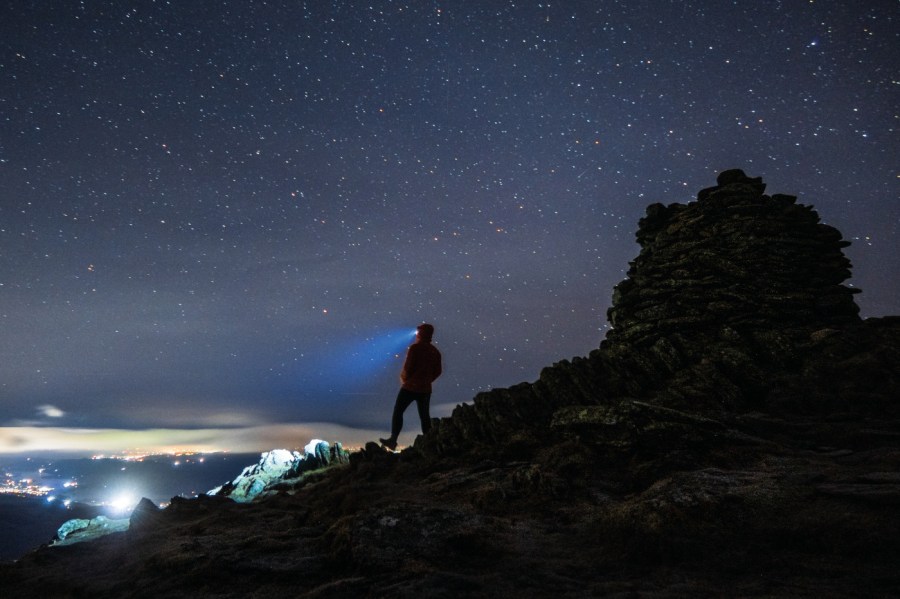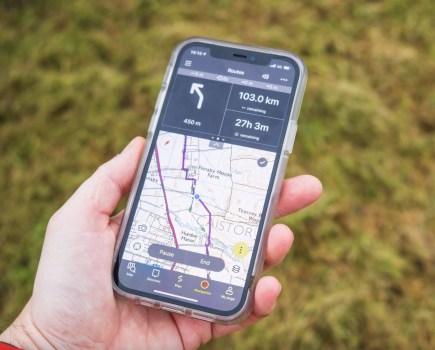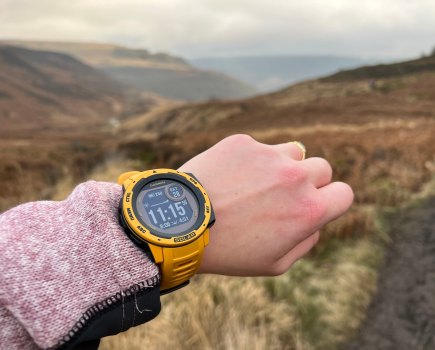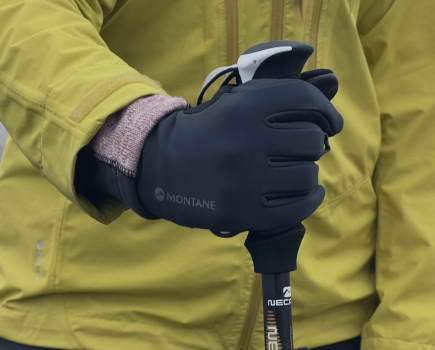Our experts test the best head torches for mountain use, detailing the best options to suit your hiking adventures.
A good head torch is an essential piece of kit to carry when out hiking, up there with a waterproof jacket or walking boots.
Planning a night out in a tent? You’ll need a light for use around camp, in the bothy or to find your way to the stream after it gets dark. Just heading out for a day walk and expect to be back before nightfall? A head torch is your insurance policy in case your route takes longer than expected – or an accident, navigation error or other mishap leads to a forced be nightment.
The best head torches for hiking reviewed 2023
In this article, you’ll find all of the head torches that performed over the course of our tests. We’ve selected a range of different options to cater for different individual needs, from head torches for winter mountaineering to lightweight options to suit those who into long-distance backpacking. We’ve also taken into consideration different budget requirements.
- Black Diamond Storm 500-R | £65 | Alex’s Best Buy
- Alpkit Qark | £40 | Lucy’s Best Buy
- Petzl Actik Core | £70 | Recommended
- Petzl Tikkina | £20
- Princeton Tec Byte 200 Lumen | £25
- Black Diamond Astro 300-R | £35
- GP Batteries XPLOR PHR17 | £33
- Silva Terra Scout XT | £40
- Biolite Headlamp 425 | £50
- Ledlenser MH5 | £65
- Coast FL20R Head-Torch 430 Lumens | £48
How we tested them
Alex Roddie
Alex tested these head torches on a variety of short backpacking trips in the Peak District, Scottish Highlands and Lake District. He also spent most of his summer trekking and running across the Alps with two of the lamps tested. Weights stated include batteries, weighed on Alex’s digital scale. Battery life is quoted for dimmest, medium and brightest settings where available.
Lucy Wallace
As part of her day job, Lucy trains and assesses future Mountain Leaders, which involves a lot of night navigation exercises! All torches were weighed on her own digital scales and include batteries.
Best in test: Black Diamond Storm 500-R
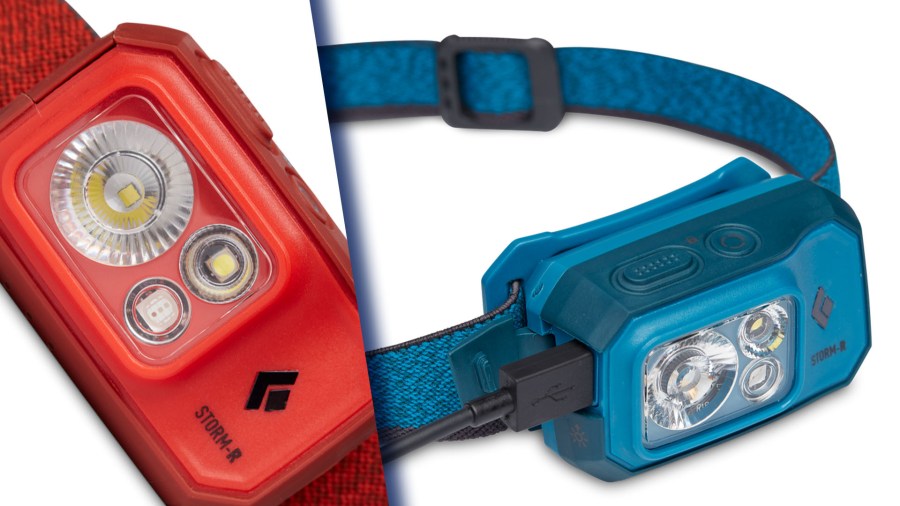
- Pros: Brightness, battery life, waterproof, intuitive controls, comfortable strap
- Available from TrekInn
- Cons: Non-swappable battery, not USB-C
- Price: £65
- Weight: 100g
Power: internal rechargeable battery (2400mAh, micro USB) | Battery life: 350/19/7 hours | Brightness: 6/250/500 lumens | Features: two buttons plus touch sensor, brightness memory, precise dimming, flood and spot, red green and blue modes, strobe, control lock, IP67 waterproof
Black Diamond has launched a new range of head lamps with better specs and new features. Battery life is stellar, easily the best tested. I found it hard to kill even on medium setting, despite offering 250 lumens here (a great sweet spot). The IP67 rating makes it completely waterproof. Although the joint heaviest lamp I tested, it’s still relatively lightweight – fine for keeping in your pack over the summer.
Read more in our Black Diamond Storm 500-R review
Alpkit Qark | Lucy’s Best Buy
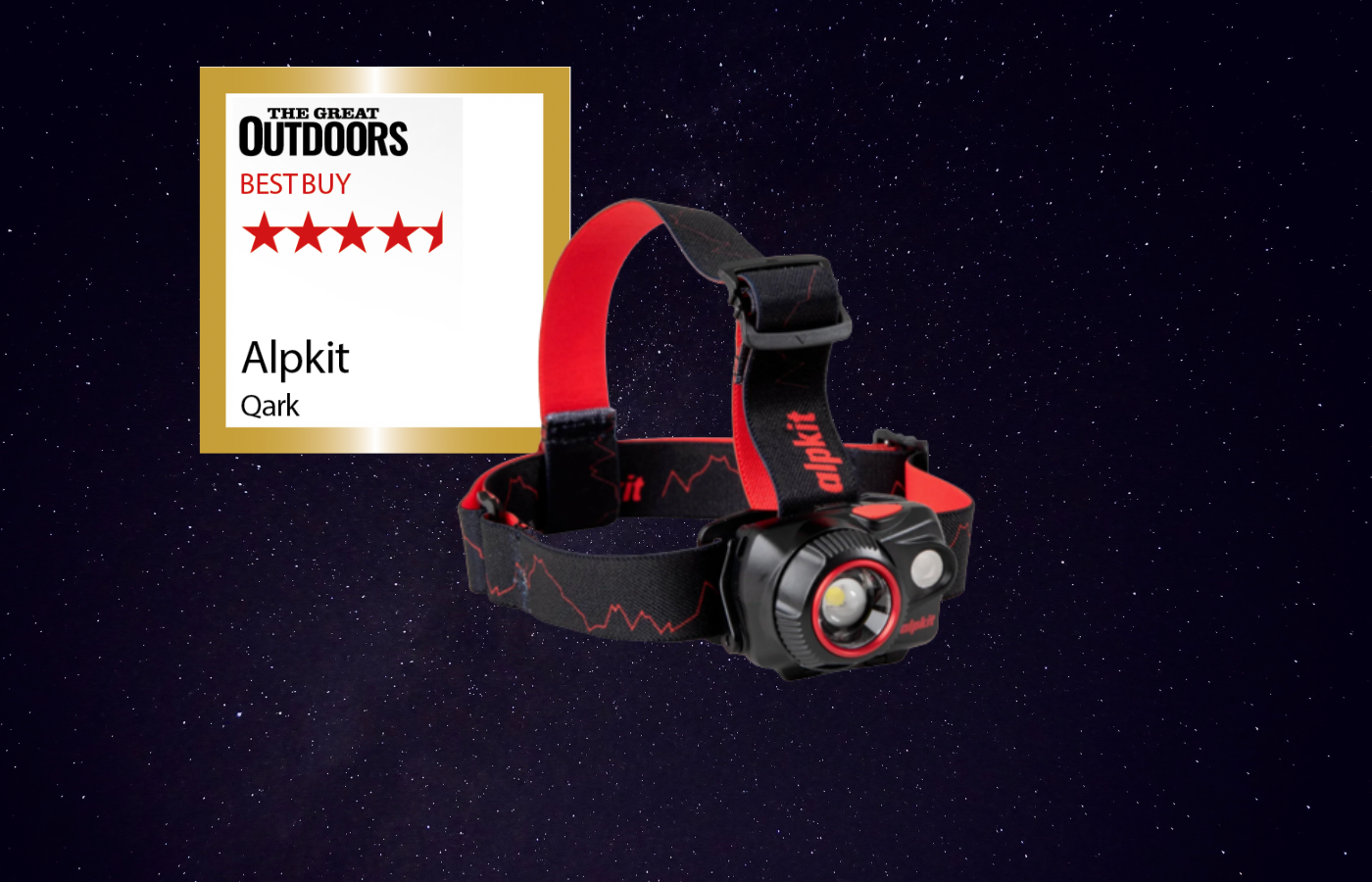
- Pros: Inexpensive, powerful, focusable beam, hybrid battery
- Cons: fiddly cradle, strobe effect in heavy rain
- Price: £40
- Weight: 111g
Output: up to 580 lumens | Power source: rechargeable 3.7V 800 mAh proprietary Li-polymer battery included (3 x AAA-compatible) | Features: focus control, three power settings and red, adjustable elastic cradle, IPX6 water-resistant
The Alpkit Qark is a lightweight, user-friendly head torch, I found the main beam easy to use and appeared to have three settings, with a focus beam that can send out up to 580 lumens over 150m according to Alpkit. It certainly seemed to light up quite a distance during testing in night time conditions. When weighed on my scales at home the Alpkit Qark came in at 111g, I found a rechargeable 3.7V 800 mAh proprietary Li-polymer battery included with the headtorch. Which also features focus control, three power settings, and an adjustable elastic cradle. The battery can be replaced with AAAs for added flexibility. The Qark is IPX6 water-resistant, making it suitable for harsh conditions in winter. However, minor gripes include the top strap on the cradle and the Cree XP-C LED’s strobe effect. Overall, the Qark offers simplicity, functionality, and durability at an affordable price.
Read Lucy’s full Alpkit Qark review
Petzl Actik Core | Recommended
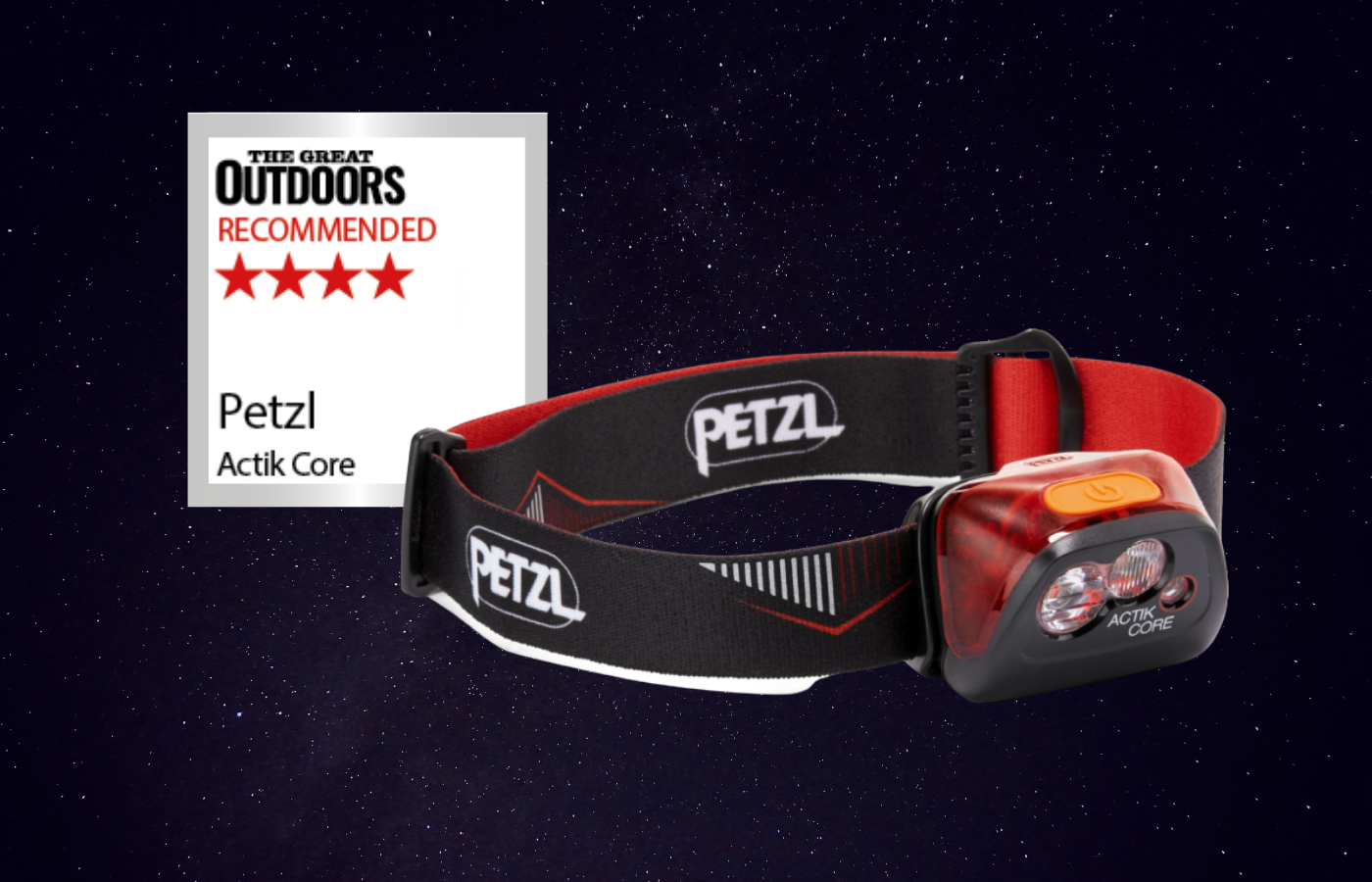
- Pros: Powerful, lightweight, hybrid battery design
- Cons: Simple flood beam only
- Price: £70
- Weight: 82g
Output: up to 600 lumens | Power source: 1250mAh CORE rechargeable battery included (compatible with 3 x AAAs) | Features: three power settings and red, adjustable elastic cradle, IPX4 water-resistant, lockable power button
The Petzl Actik Core is a compact, easy-to-use head torch with a powerful output on full beam. During testing i found the Petzl Actik to have three power settings and a rechargeable battery that lasts around 2 hours. The torch has a lockable power button and a red, adjustable elastic cradle. It comes with a hybrid battery pack that can be replaced with AAA batteries. The head strap is comfortable and easy to adjust. The torch is IPX4 water-resistant and has a lockable power button. Although slightly more expensive than some competitors, it’s a worthwhile investment for reliable equipment.
Read Lucy’s full review on the Petzl Actik Core
Petzl Tikkina | Best Budget Option
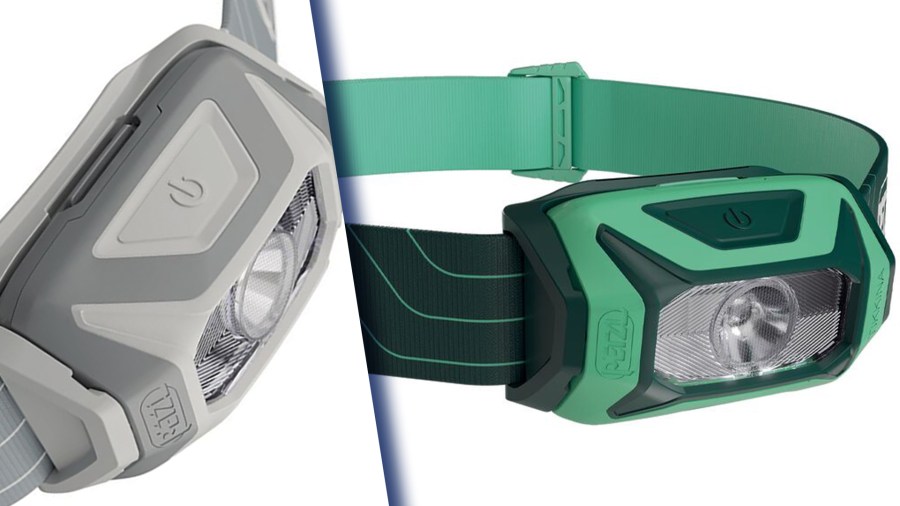
- Pros: Price, easy to use
- Cons: Hinge design, no red mode, no battery indicator
- Price: £20
- Available from Alpine Trek
- Weight: 92g
Power: 3xAAA or optional Core rechargeable battery (1250mAh, micro USB) | Battery life: 100/10/2 hours (AAA) or 120/7/3 hours (Core) | Brightness: 7/100/300 lumens (AAA or Core) | Features: one button, flood, IPX4 water-resistant
I’ve been using Petzl’s classic Tikka and Tikkina lamps for a while now, and it’s been fascinating to see how they’ve evolved over the years. In 2022, the design took on a wider, more contemporary look, and a new hinge was introduced. It’s a bit of a departure from the older models, but in a good way.
The first thing I noticed was the improved brightness. The new model is significantly brighter than the older one, which is a welcome change, especially when I’m out and about in the dark. The added illumination has proven to be quite handy.
However, one thing that remained consistent is the battery life. It’s still about the same, which is good news because I’ve always found it to be reliable in this department. It’s a reassuring feature when you’re relying on your headlamp for extended periods during outdoor activities.
All in all, this torch remains a trusty companion for backup summer use and close-range lighting around camp. The updated design and enhanced brightness make it a worthy addition to my backpack
Read more in our full review of the Petzl Tikkina review
Black Diamond Astro 300-R – Best beginners head torch
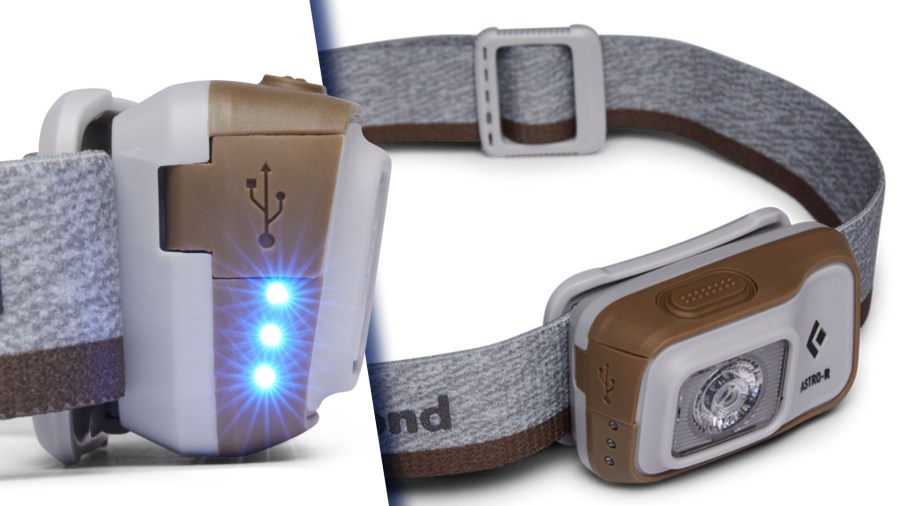
- Pros: Good value, easy to use, battery life, comfortable strap
- Cons: No red mode, non-swappable battery, not USB-C
- Price: £35
- Available from TrekInn
- Weight: 75g
Power: internal rechargeable battery (1500mAh, micro USB) | Battery life: 140/12/6 hours | Brightness: 6/150/300 lumens | Features: one button, brightness memory, dimming, flood, strobe, control lock, IPX4 water-resistant
The Astro 300-R has been my go-to head torch for three-season backpacking, and it’s interesting to note how it fits into the Black Diamond lineup. When you look at it, you can see that it’s like a slimmer, more streamlined version of the Storm 500-R, and there are quite a few design similarities.
The most noticeable difference, of course, is that it comes at just over half the price, which is quite appealing. However, to achieve that cost reduction, you get a headlamp with a single LED and a smaller battery. But this trade-off is worth considering, especially if you value a lighter load on your backpacking trips.
One thing I appreciate about the Astro 300-R is its simplicity. The controls are straightforward and easy to use, which is a refreshing change from some of the more complex headlamps out there. While it might not have the red mode or a super-bright boost that the higher-end models offer, it still gets the job done efficiently.
If you can do without those extra features, the Astro 300-R is an excellent choice. It’s well-made, competitively priced, and has proven itself as a reliable companion for three-season backpacking adventures.
Read more in our Black Diamond Astro 300-R review
GP Batteries PHR17
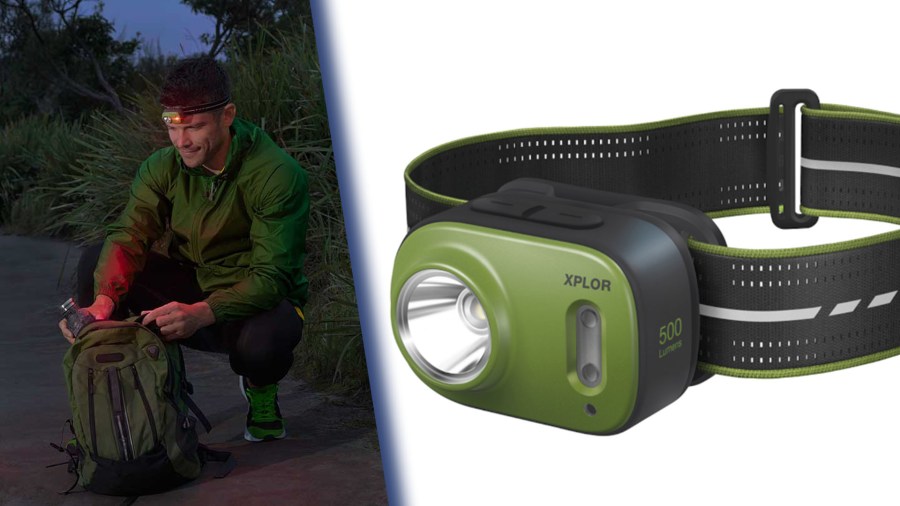
- Pros: Good value, good red mode, USB-C
- Cons: Controls, strap not the best, not every USB-C cable fits, non-swappable battery
- Price: £33
- Weight: 77g
Power: internal rechargeable battery (1600mAh, USB-C) | Battery life: 100/9/4/3 hours | Brightness: 5/60/200/500 lumens | Features: two buttons, red mode, flood and spot, strobe, control lock, IPX6 water-resistant, 1m shock-resistant
I’ve been using the GP Batteries PHR17, which is marketed as a trail running light but has proven to be versatile enough for hiking and backpacking as well. It’s an affordable option that offers some pretty decent features.
One of the highlights is the good battery life and brightness it delivers. It’s reliable in providing the illumination needed for outdoor adventures, although I did notice that the real-world run times are slightly shorter than what’s claimed, which is something to keep in mind.
Charging it via USB-C is convenient, but I did run into a minor issue with the recessed port. Some of my cables didn’t quite fit, which could be a bit frustrating, especially when you’re on the go.
The strap, on the other hand, could use some improvement. It’s stiff and not the most comfortable, and it tends to tangle easily. However, considering the price point of this headlamp, these drawbacks are relatively easy to overlook. The affordability and overall performance make it a practical choice for outdoor enthusiasts, and I’m willing to forgive these minor inconveniences.
Read our full review GP Batteries XPLOR PHR17 review
Silva Terra Scout XT
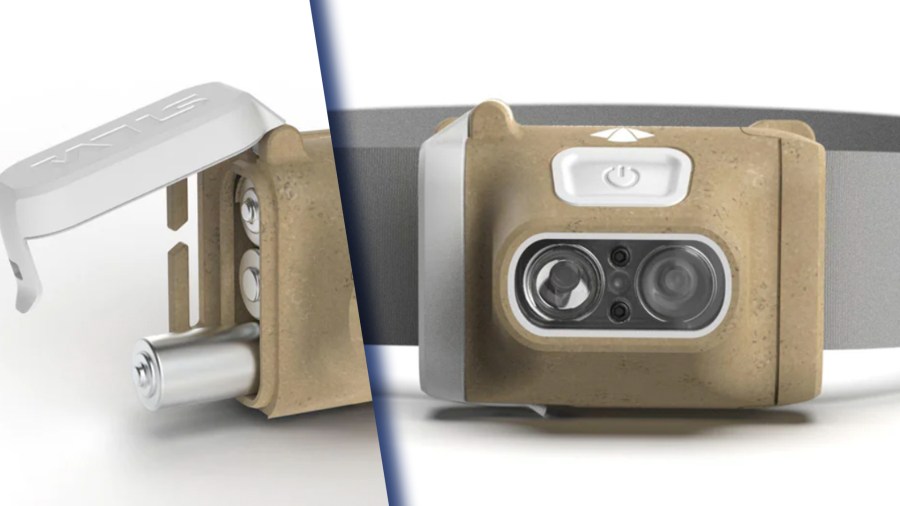
- Pros: Sustainable materials, controls
- Cons: Battery latch, battery life
- Price: £40
- Available from Go Outdoors
- Weight: 100g
Power: 3xAAA batteries or optional Hybrid rechargeable battery (1250mAh, USB-C) | Battery life: 5/32 hours (in practice 30/70 hours) | Brightness: 50/350 lumens | Features: one button, precise dimming, red mode, flood and spot, strobe, control lock, IPX5 water-resistant
I’ve had the opportunity to use Silva’s Terra Scout XT, which is a variation of their Scout 3XTH head torch. What sets it apart is the materials used in its construction. It’s made from hemp and recycled plastics, which is a significant step towards environmental sustainability. Silva claims it has up to a 90% lower carbon footprint than standard plastics, which is a commendable effort.
One notable feature is that it offers only two brightness modes: low and high. Interestingly, even the low setting is brighter than what you’d find in most other torches. However, this does come at a cost – the battery life is not as impressive. While it’s suitable for general hillwalking and provides enough illumination, it might not be the top choice for extended use, especially when you’re far from a power source.
Overall, the Terra Scout XT is a good option if you value sustainability in your gear and primarily need a head torch for shorter outings. The unique choice of materials and decent real-world performance make it a respectable choice for environmentally conscious users, although it might not be ideal for those who require extended battery life.
Read our full review of the Silva Terra Scout XT review
Best lightweight head torch: Princeton Tec Byte 200 Lumen
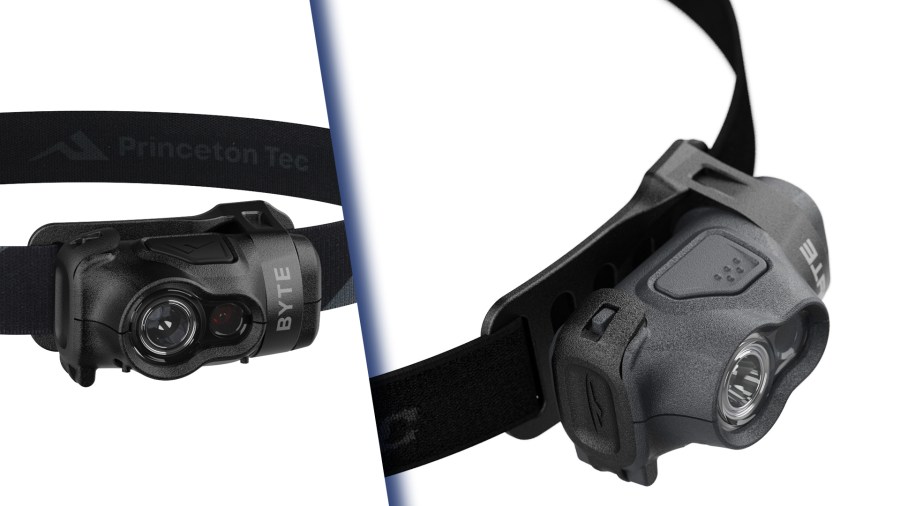
- Princeton Tec Pros: Price, lightweight and compact, great if you like red mode
- Cons: Battery life, no easy recharging from power bank
- Price: £25
- Available from Outdoor Action
- Weight: 61g
Power: 2xAAA batteries | Battery life: 140/66/12/3.4 hours | Brightness: 1/4/50/200 lumens | Features: one button, red mode, spot, control lock, IPX4 water-resistant
I’ve had the chance to explore the Byte 200, a head torch that’s been around for some time but recently received an upgrade with a brighter white LED. What immediately stands out is its size and weight – it’s the smallest and lightest torch in its category that I’ve tested.
Despite its compact form, the Byte 200 manages to pack enough power for various uses, making it versatile for general purposes as well as serving in emergency backup roles. Its brightness and performance are commendable for its size, but it’s worth noting that it might not be the best choice for extended night walking.
For short periods or brief stints, it can suffice, but I’d recommend carrying spare batteries if you plan on relying on it for more extended nighttime adventures. All in all, the Byte 200 is a practical, lightweight option that excels in its compactness and versatility, making it suitable for a range of tasks.
Red our full review on the Princeton Tec Byte 200 Lumen review
BioLite Headlamp 425
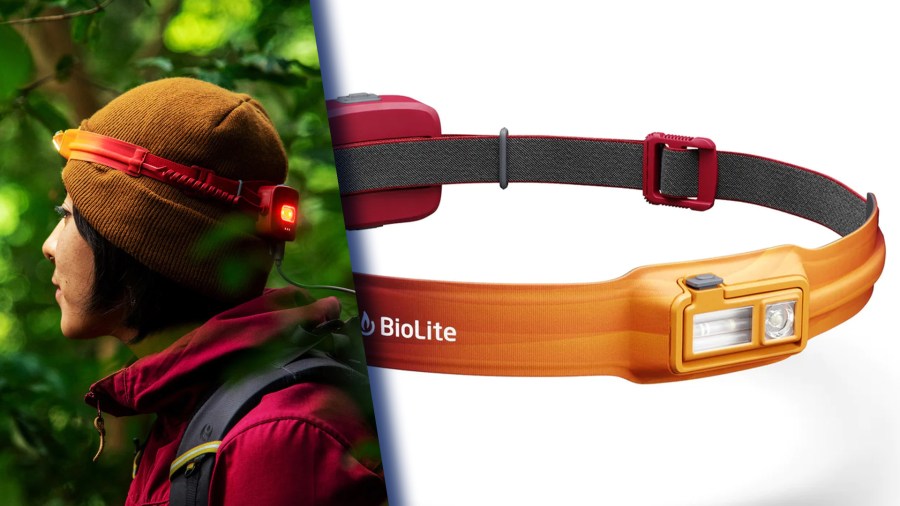
- Pros: Weight, brightness, strap comfort, USB-C, waterproof
- Cons: Battery life, glare for glasses wearers, non-swappable battery
- Price: £50
- Available from BioLite & Go Outdoors
- Weight: 81g
Power: internal rechargeable battery (1000mAh, USB-C) | Battery life: 60/3.5 hours | Brightness: up to 425 lumens | Features: two buttons, red mode, flood and spot, strobe, rear indicator, IP67 waterproof
I’ve had the chance to try out BioLite’s headlamp, which certainly stands out in terms of design. What makes it unique is the molded straps that are integrated into the front lighting unit, giving it a distinctive look.
One feature I liked is that the headlamp has a rear-mounted battery pack, a departure from the typical headlamp design. Surprisingly, it’s relatively small and doesn’t noticeably affect comfort during use.
In terms of performance, I did experience some deviations from the manufacturer’s claims. While they advertise a 60-hour runtime on the low setting, I found that it fell a bit short, giving me closer to 48 hours. On the high mode, the battery drains quite rapidly, lasting only about 2 hours.
The BioLite headlamp is undoubtedly a unique and visually appealing option, and the rear-mounted battery pack doesn’t hinder comfort. However, it’s essential to be aware of the actual battery life, which may not align perfectly with the manufacturer’s specifications. If you value style and don’t mind the trade-offs in battery life, it’s worth considering.
Read our full review on the BioLite HeadLamp 425
Ledlenser MH5
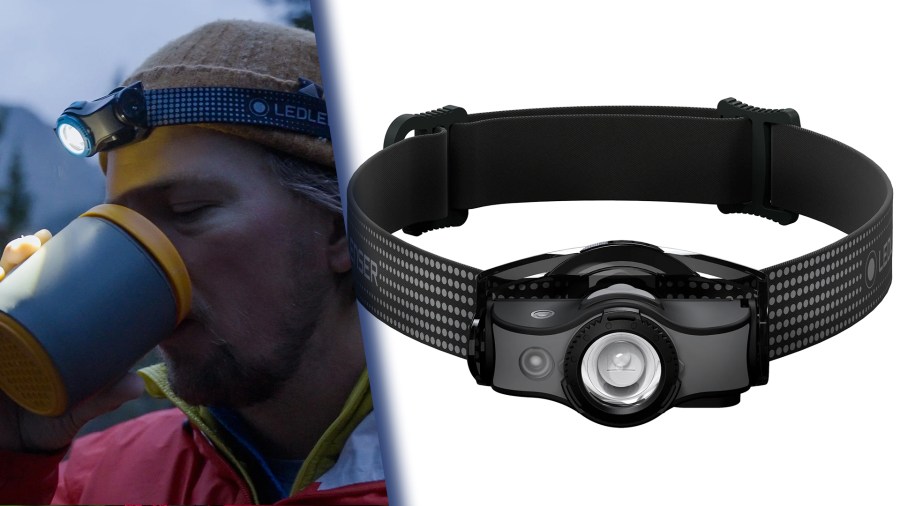
- Pros: Converts into hand torch, excellent spot mode
- Cons: Proprietary charging cable, poor flood mode, battery life
- Price: £65
- Available from Go Outdoors
- Weight: 95g
Power: rechargeable battery (750mAh, magnetic charging cable) or 1xAA | Battery life: 35/4 hours | Brightness: 20/400 lumens | Features: one button, red mode with memory, adjustable spot, detachable strap, pocket clip, IP54 water-resistant
This flashlight has a singular mission: to project an intense, far-reaching spotlight beam. The high spot mode, with its impressive 400 lumens, can be adjusted using a lens to create a focused beam that reaches nearly 200 meters. It excels at this specific task, providing a powerful and concentrated light.
However, where this flashlight falls short is in its flood mode. Even at its widest setting, the beam retains a hard-edged quality that’s less than ideal for close-range tasks. It lacks the versatility to handle both long-distance and short-range illumination effectively.
A caveat with this flashlight is its battery life. While it claims a 35-hour runtime on the low setting, my experience was different, and I could only manage around half that time. On the high setting, the battery drained much faster than expected, lasting closer to 2 hours rather than the advertised 4.
If you have a specific need for a long-distance, tightly focused beam, this flashlight is certainly worth considering. However, be prepared for some compromises in terms of battery life and its limited suitability for close-range tasks.
Read our full review on the Ledlenser – MH5
Coast FL20R
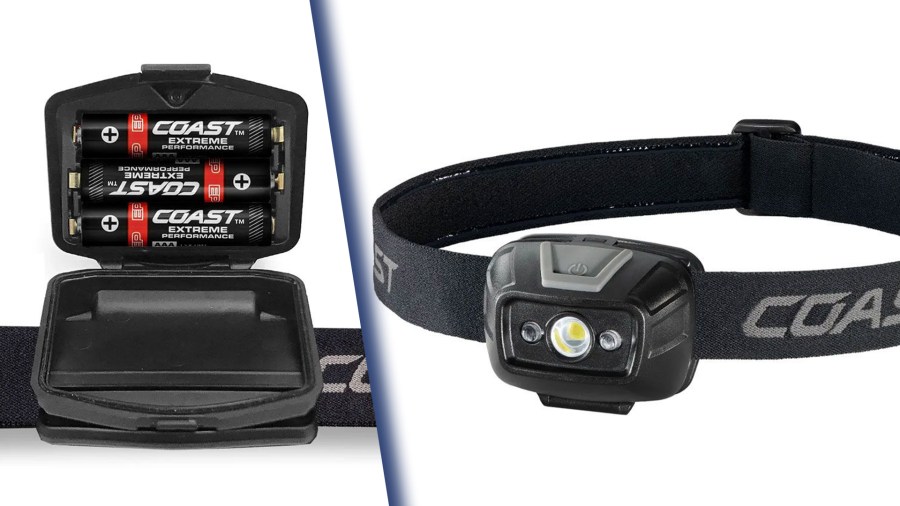
- Pros: Easy to use, good strap
- Cons: Price, battery life, construction
- Price: £48
- Weight: 78g
Power: internal rechargeable battery (1000mAh, micro USB) or 3xAAA | Battery life: up to 19 hours | Brightness: up to 430 lumens | Features: one button, red mode, flood, IP54 water-resistant
The Coast FL20R headlamp can be best described as straightforward and functional. It features a simple design, equipped with a large white LED and small red LEDs for different lighting needs.
It features a gasket-sealed battery compartment, which houses a micro USB-rechargeable battery pack. An interesting aspect is that it’s adaptable, allowing you to swap it out for AAA batteries if needed. This versatility can come in handy, especially when you’re in situations where recharging isn’t an option.
The beam is marketed as a ‘flood,’ but in reality, it falls a bit short of that promise. The beam remains hard-edged and not as expansive as you might expect from a floodlight. This might limit its effectiveness in situations that require broad illumination.
On the positive side, the rechargeable battery pack is reasonably priced, making it convenient to keep spare batteries on hand. As for construction, it’s relatively basic, and the plastic used might not feel as high-quality compared to some other options. Nevertheless, despite its simplicity, it has proven to be durable in my experience so far.
In summary, this headlamp offers a no-frills, versatile lighting solution. Its adaptability to accommodate both rechargeable and AAA batteries, along with its durability, can make it a practical choice. However, be aware of the slightly limited beam performance and the basic construction, which might feel a bit cheap compared to more premium models.
Read our full review on the Coast FL20R Head-Torch 430 Lumens
What To Look For When Buying a Head Torch
In the darker months, I like a dependable light with good battery life, a bright long-range beam that can be used for following vague trails, and controls that are easy to use with gloves. Although a head torch is most important from autumn through to spring, I’ll usually carry one in summer as well.
In summer I’m less likely to need it for actually hiking – and nights tend to be less dark. Extended battery life at full burn and trail-finding performance are less important in summer. I probably won’t need to use it with hiking gloves on, and it may sit in my pack unused for long periods.
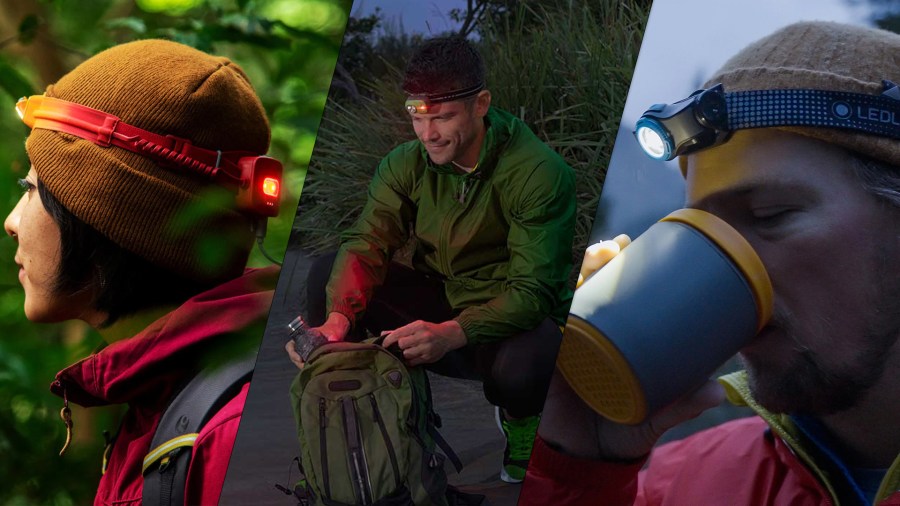
Head torch options from Biolite, GP Batteries and Ledlenser.
I look for a lightweight, compact package and decent battery life on the low power setting; at this time of year a torch is most likely to be used for short periods at close range in camp.
Some walkers will end up with two torches: a beefier winter model and a slimmed-down one for summer use. However, advances in tech mean that many lightweight, compact models now pack in a lot of performance and battery life. In this review I have selected torches across this good middle-ground spectrum, ideal for the needs of average walkers and backpackers.
For other things to consider when choosing a head torch for outdoor use, including a guide to brightness/lumens, it’s worth taking a look at our full head torch buyer’s guide.
Features of a head torch
Here’s what the best head torches have when it comes to features and functions…
Battery life: For winter use, I look for at least 100 hours on low burn, and at least 10 hours on a setting bright enough to follow a bearing after dark in poor visibility. For summer, around 100 hours on low burn and 2-3 hours on a higher setting is sufficient for me.
Power source: Recharging via USB from a power bank is great for multi-day use. Most still have micro USB sockets; if your phone takes a USB-C cable, a USB-C-compatible torch is better. Some can take either a removable rechargeable battery or AA/AAA cells. This is great for winter as AA/AAA lithium cells last longer below zero. It also makes it easier to swap out batteries on the go. If your torch has a sealed battery, then it must be recharged from a power bank or mains charger when depleted.
Brightness: Brightness is measured in lumens. Low setting (often 5-10 lumens) is fine for use at close range in a tent.
I look for about 200 lumens for night hiking on trails, and up to 400-500 for winter mountaineering. Some torches have brightness memory – they’ll remember the last setting used and switch back on to the same brightness next time.
Features: Most torches offer both white light and a red setting, good for preserving night vision. A strobe mode can be useful in emergency situations. Many torches offer a spot beam for trail finding as well as a flood beam.
Weather resistance: Every torch tested is water-resistant; IPX4 is the minimum (resistant to rain, but not submersible). IPX6 is better, but only IPX7 and IP67 are tested
for immersion in water. For winter use, I look for at least IPX6.
Size and weight: Every torch tested weighs 100g or less. Although some heavier models with large rear-mounted battery packs do offer better battery life, these are cumbersome and only needed for extended use in the most extreme conditions.
Controls: Most torches have a single button; some have two or even three. Look for simple, intuitive controls that are easy to use when wearing gloves. A control lock stops the torch from coming on accidentally in your pack.
Comfort: A comfortable and easily adjustable strap is essential. Also important is the hinge, which should offer a good range of movement and hold its position when adjusted. The LEDs should not spill any light down onto your face (this can cause glare for glasses wearers).

